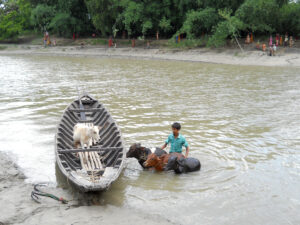
© Saikhom Kennedy
In September 2025, the International Committee of the Red Cross (ICRC) convened a dedicated side session on livestock livelihoods and emergencies during its annual Economic Security Agro-Livestock Workshop. The session, attended by almost 30 veterinarians and agriculture specialists from across Africa, the Middle East and Asia, provided an opportunity to engage directly with LEGS Coordinator Cathy Watson, who gave a refresher and update on the LEGS Handbook and training programme.
Notably, around 70% of participants in the side session had previously received LEGS Core Training, bringing valuable field perspectives and experience to the discussions. Since 2011, ICRC has commissioned 21 LEGS Core Training courses worldwide, demonstrating a sustained commitment to promoting good practice in livestock-based humanitarian response.
Participants began by reflecting on the impacts of conflict and disaster on livestock and livelihoods in the contexts where they work. A live poll generated a striking word cloud in which “loss of livestock,” “insecurity,” “reduced production,” and “loss of income” dominated – underscoring the centrality of livestock in crisis-affected communities.
Cathy provided a quick overview of the LEGS Handbook, highlighting features of the latest version, including the new standards on preparedness, updated participatory planning tools, and improved design for easier use. She emphasised the evidence-based nature of LEGS and its role within the Humanitarian Standards Partnership, alongside Sphere and other sectoral standards.
Breakout group discussions allowed participants from West Africa, East Africa, the Middle East and Asia to share their experiences and challenges in applying LEGS. Key themes included:
- Capacity gaps: Several groups highlighted the need for more training in LEGS, including for community animal health workers, and better integration of LEGS into government systems and curricula.
- Operational challenges: Access constraints often make it difficult to conduct participatory tools such as the PRIM (Participatory Response Identification Matrix) in the field.
- Continuity and sustainability: Limited budgets, short project cycles, and lack of government buy-in were cited as barriers to sustaining livestock interventions beyond the immediate emergency.
- Contextualisation: Some felt that examples in the LEGS Handbook are weighted toward East and West Africa, highlighting the need for more regionally-relevant case studies and adaptations, particularly for the Middle East.
The session also drew attention to resources available through LEGS, including in-person and online training, technical briefs, and a growing bank of case studies covering a range of contexts and geographic regions.
Participants agreed on the value of closer collaboration between ICRC and LEGS, and exploring links with universities and professional training bodies to embed LEGS more systematically. As one participant noted, “LEGS provides us with a vital toolbox – but we need to adapt and sustain it within our own contexts.”
During the main Workshop, another dedicated session focussed on the Joint Assessment Tool (JAT) – a co-publication of LEGS and SEADS designed to streamline assessment processes across the crop and livestock sectors. This discussion reinforced the importance of cross-sectoral coordination in emergency response and recovery.
Livestock programs remain a cornerstone of the ICRC’s humanitarian response. Pastoralist and agro-pastoralist communities often find themselves at the intersection of conflict and climate change, both affected by violence and, at times, directly involved in it, which highlights the essential role of the ICRC in engaging with these groups to protect and assist people impacted by conflict worldwide.

